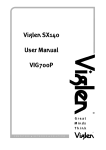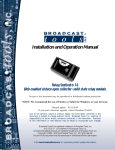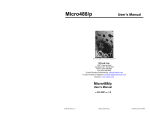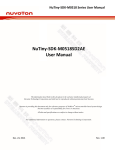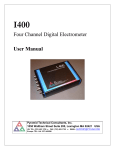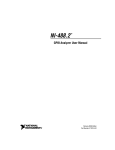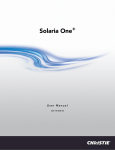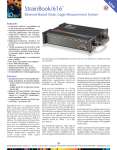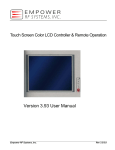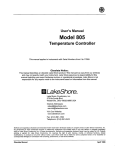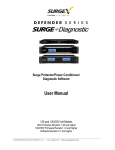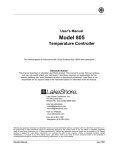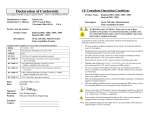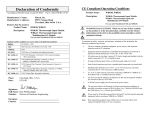Download Isolator488 Users Manual
Transcript
Isolator488 IEEE 488 Bus Isolator USER’S MANUAL IOtech, Inc. • 25971 Cannon Road • Cleveland, Ohio 44146 • (440) 439-4091 Warranty Information Your IOtech warranty is as stated on the product warranty card. You may contact IOtech by phone, fax machine, or e-mail in regard to warranty-related issues. Phone: (440) 439-4091, fax: (440) 439-4093, e-mail: [email protected] Limitation of Liability IOtech, Inc. cannot be held liable for any damages resulting from the use or misuse of this product. Copyright, Trademark, and Licensing Notice All IOtech documentation, software, and hardware are copyright with all rights reserved. No part of this product may be copied, reproduced or transmitted by any mechanical, photographic, electronic, or other method without IOtech’s prior written consent. IOtech product names are trademarked; other product names, as applicable, are trademarks of their respective holders. All supplied IOtech software (including miscellaneous support files, drivers, and sample programs) may only be used on one installation. You may make archival backup copies. FCC Statement IOtech devices emit radio frequency energy in levels compliant with Federal Communications Commission rules (Part 15) for Class A devices. If necessary, refer to the FCC booklet How To Identify and Resolve Radio-TV Interference Problems (stock # 004-000-00345-4) which is available from the U.S. Government Printing Office, Washington, D.C. 20402. CE Notice Many IOtech products carry the CE marker indicating they comply with the safety and emissions standards of the European Community. As applicable, we ship these products with a Declaration of Conformity stating which specifications and operating conditions apply. Warnings, Cautions, Notes, and Tips Refer all service to qualified personnel. This caution symbol warns of possible personal injury or equipment damage under noted conditions. Follow all safety standards of professional practice and the recommendations in this manual. Using this equipment in ways other than described in this manual can present serious safety hazards or cause equipment damage. This ESD caution symbol urges proper handling of equipment or components sensitive to damage from electrostatic discharge. Proper handling guidelines include the use of grounded anti-static mats and wrist straps, ESD-protective bags and cartons, and related procedures. Specifications and Calibration Specifications are subject to change without notice. Significant changes will be addressed in an addendum or revision to the manual. As applicable, IOtech calibrates its hardware to published specifications. Periodic hardware calibration is not covered under the warranty and must be performed by qualified personnel as specified in this manual. Improper calibration procedures may void the warranty. Quality Notice IOtech has maintained ISO 9001 certification since 1996. Prior to shipment, we thoroughly test our products and review our documentation to assure the highest quality in all aspects. In a spirit of continuous improvement, IOtech welcomes your suggestions. Isolator488 Instruction Manual Part No. Isolator488-901 Revision 1.2 December 1991 IOtech, Inc. 25971 Cannon Road Cleveland, Ohio 44146 (440) 439-4091 IMPORTANT! READ THIS BEFORE INSTALLATION! WARNING The enclosure of the Isolator488 Bus Isolator is internally connected to earth ground through the power cord. However, the shield of the IEEE 488 cables attached to the Isolator488 and signal ground pins may be at a high voltage with respect to earth ground. Be sure to remove power from all devices in your system before handling IEEE 488 cables connected to the Isolator488. Failure to follow this warning may result in personal injury or death. IOtech, Inc. • 25971 Cannon Road • Cleveland, Ohio 44146 • (440) 439-4091 Table of Contents Section 1 1.1 1.2 1.3 1.4 INTRODUCTION General Description Available Accessories Specifications Abbreviations Page 1.1 1.1 1.2 1.3 Section 2 2.1 2.2 2.3 2.4 2.5 2.6 GETTING STARTED Inspection Configuration Modifications Line Voltage Selection Hardware Installations Operation BusLoading Cabling Length Signal Line Direction Parallel Polling Passing Control Page 2.1 2.1 2.4 2.7 2.9 2.10 2.11 2.11 2.12 2.13 2.13 IEEE 488 Primer History General Structure Send It To My Address Bus Management Lines Attention (ATN) Interface Clear (IFC) Remote Enable (REN) End Or Identify (EOI) Service Request (SRQ) Handshake Lines Data Valid (DAV) Not Ready For Data (NRFD) Not Data Accepted (NDAC) Data Lines Multiline Commands Page 3.1 3.1 3.5 3.5 3.5 3.6 3.6 3.6 3.6 3.7 3.7 3.7 3.7 3.8 3.8 2.6.1 2.6.2 2.6.3 2.6.4 2.6.5 Section 3 3.1 3.2 3.3 3.4 3.4. 3.4.2 3.4.3 3.4.4 3.4. 3.5 3.5.1 3.5.2 3.5.3 3.6 3.7 Section 3 (cont.) 3.7.1 3.7.2 3.7.3 3.7.4 3.7.5 3.7.6 3.7.7 3.7.8 3.7.9 3.7.10 3.7.11 3.7.12 3.7.13 3.7.14 3.7.15 3.8 3.8.1 3.8.2 Go To Local (GTL) Listen Address Group (LAG) Unlisten (UNL) Talk Address Group (TAG) Untalk (UNT) Local Lockout (LLO) Device Clear (DCL) Selected Device Clear (SDC) Serial Poll Disable (SPD) Serial Poll Enable (SPE) Group Execute Trigger (GET) Take Control (TCT) Secondary Command Group (SCG) Parallel Poll Configure (PPC) Parallel Poll Unconfigure (PPU) More On Service Requests Serial Poll Parallel Poll Page 3.8 3.9 3.9 3.9 3.9 3.9 3.9 3.10 3.10 3.10 3.10 3.10 3.10 3.11 3.11 3.11 3.12 3.12 Section 4 4.1 SERVICE INFORMATION Factory Service Page 4.1 Appendix A Character Codes and IEEE Multiline Messages Section 1 Introduction Introduction 1.1 GENERAL DESCRIPTION The Isolator488 increases the number of IEEE instruments and devices allowable on the bus from 15, including the controller, to 28 while also providing optical isolation between the system controller and devices on the isolated bus. Since the Isolator488 does not occupy a bus address, its operation is entirely transparent to the IEEE controller. The IEEE standard defines 31 valid primary bus addresses. Therefore, no special software or bank switching is necessary to access the additional devices allowed by the Isolator488. The Isolator488 and has no effect on bus data transfer rates. Two IEEE ports are provided. One connects directly to the controller's IEEE bus, the other to an additional 14 instruments, printers, plotters and specialized peripherals which may need to be optically isolated from the system controller. 1.2 AVAILABLE ACCESSORIES Additional accessories that can be ordered for the Isolator488 include: 123-0900 CA-7-1 CA-7-2 CA-7-3 CA-7-4 CN-20 CN-21 CN-22 CN-23 Instruction Manual 1.5 foot IEEE 488 cable 6 foot IEEE 488 cable 6 foot Shielded IEEE 488 cable Reverse entry 6 foot IEEE 488 cable Right Angle IEEE 488 adapter, male and female IEEE 488 connector Extender, male and female IEEE 488 multi-tap bus strip, four female connectors wired in parallel. IEEE 488 panel mount feed-through connector, male and female 1.1 Section 1 Introduction 1.3 SPECIFICATIONS PROPAGATION DELAYS: Local to Remote Talker Data Lines Command Lines Remote to Local Talker /ATN to Local Data /ATN to Local DAV Data Lines Command Lines Parallel Poll Response SIGNAL LINE DIRECTIONS: Data Lines: DIO1 - DIO7 Handshake Lines: DAV, NRFD, NDAC Command Lines: SRQ, ATN, REN, IFC ATN EOI CONNECTORS: INDICATORS: POWER: ENVIRONMENT: DIMENSIONS: WEIGHT: CONTROLS: SUPPLIED ACCESSORIES: ISOLATION: 85 nS typ., 90 nS typ., 120 125 nS Max. nS Max. 355 155 85 90 140 475 2075 120 125 205 nS Max. nS Max. nS Max. nS Max. nS Max. nS typ., nS typ., nS typ., nS typ., nS typ., Bidirectional Bidirectional To Local Bus To Remote Bus Bidirectional Two IEEE 488 connectors with metric studs LED for Power 105-125V or 210-250V,50, 60 Hz; 20 VA MAX. 0 to 50 °C; 0 to 70% RH 425 mm deep x 45 mm wide x 208 mm high. (16.75 "x 1.75 "x 8.20 ") 2.1 kg (4.6 lbs) Power switch Power cable and manual IEEE 488 common on Controller Bus to IEEE 488 common on Instrument Bus: 1600 volts peak maximum @ sea level to 10,000 ft. 0 - 70° C, and 0 - 80% RH non-condensing OR 500 Vac maximum, 105V-Hz Specifications are subject to change without notice. 1.2 Section 1 Introduction 1.4 Abbreviations The following IEEE 488 abbreviations are used throughout this manual. addr n ATN CA CR data DCL GET GTL LA LAG LF LLO MLA MTA PPC PPU SC SDC SPD SPE SRQ TA TAD TCT term UNL UNT * IEEE bus address "n" Attention line Controller Active Carriage Return Data String Device Clear Group Execute Trigger Go To Local Listener Active Listen Address Group Line Feed Local Lock Out My Listen Address My Talk Address Parallel Poll Configure Parallel Poll Unconfigure System Controller Selected Device Clear Serial Poll Disable Serial Poll Enable Service Request Talker Active Talker Address Take Control Terminator Unlisten Untalk Unasserted 1.3 Section 2 Getting Started GETTING STARTED 2.1 Inspection The Isolator488 was carefully inspected, mechanically and electrically, prior to shipment. When you receive the interface, carefully unpack all items from the shipping carton and check for any obvious signs of physical damage which may have occurred during shipment. Report any damage to the shipping agent immediately. Remember to retain all shipping materials in the event that shipment back to the factory becomes necessary. Every Isolator488 is shipped with the following.... • Isolator488 • 123-0900 • 123-0800 IEEE Bus Isolator Instruction Manual Accessory Kit ( includes power cable, fuse, and rack mounting hardware) 2.2 Configuration Before using the Isolator488, you should be aware of the connections between the IEEE digital commons, the shield lines on each bus, and earth ground. The following information is provided so that you can determine if the factory configuration is appropriate for your application or if some changes need to be made prior to use. The following is a list of terms and their definitions as used in this manual: Isolation The ability of the Isolator488 to break the electrical connection between the shields and digital commons of its IEEE 488 ports while allowing the transfer of data. 2.1 Section 2 Getting Started Earth Ground The Ground terminal on the AC power cable. This is internally connected to the chassis of the Isolator488. Controller Port The IEE 488 port labeled CONTROLLER on the rear panel of the Isolator488. The system controller must be connected to this port. Instruments may also be connected to this port, but instruments placed in the CONTROLLER port will not be isolated from the system controller. Instrument Port The IEEE488 port labeled INSTRUMENTS on the rear panel of the Isolator488. Instruments may be connected to this port. Instruments connected to the Instrument Port may be isolated from devices on the Controller Port depending on the internal configuration of the Isolator 488. Controller Common The logic common connection on the Controller Port. Pins 18, 19, 20, 21,22, 23, and 24 of the Controller Port are all connected to Controller Common. Instrument Common The logic common connection on the Instrument Port. Pins 18, 19, 20, 21, 22, 23, and 24 of the Controller Port are all connected to Instrument Common. Controller Shield The Shield connection (Pin 12) on the Controller Port. Instrument Shield The Shield connection (Pin 12) on the Instrument Port The factory configuration of the Isolator488 is as follows: 2.2 Section 2 Getting Started 2.3 Section 2 Getting Started As shown in the preceding diagram, the Isolator488 is shipped with a 'soft ground' consisting of a 1 MΩ resistor in parallel with a 0.01 µF capacitor between local Common and Earth Ground. This configuration should be suitable for most applications. If you wish to make any changes to this configuration, follow the steps given below. 2.3 Modifications The Isolator488, as shipped from the factory, is configured for the typical use of the unit which is to isolate the instrument port from Earth ground and from Controller common. The factory configuration should be used unless you have a significant variation in your application beyond galvanic isolation devices on the Instrument port. If the factory configuration is not appropriate for your application, the following procedures may be undertaken to modify the Isolator488. It is necessary to open the enclosure to make any of the following changes. If yoou have any questions about a particular change, please contact the applications department at (440) 439-4091. 1. Disconnect the power cord from the AC line and from the Isolator488. Disconnect any IEEE cables prior to disassembly. WARNING Never open the Isolator488 case while it is connected to the AC line. Internal voltage potentials exist which could cause personal injury or death. 2. Place the Isolator488 on a flat surface. Remove the six screws on top of the case and remove the top cover. Located to the right of the Controller Port IEEE 488 connector are locations for C16, R4, and F2. Located to the right of the Instrument Port IEEE 488 connector are locations for C59, R5, and F3. Refer to the following figure: 2.4 TO CONTROLLER JPR1 F2 R4 C16 Common Components Controller Port C47 C48 C50 F3 Common Components Instrument Port TO INSTRUMENTS JPR2 C49 Isolator488 Internal View R5 C59 Section 2 Getting Started 2.5 Section 2 Getting Started The following options are available on each port: 1. The Shield pin of the IEEE 488 connector (pin 12) may be connected to the logic common of the IEEE 488 connector (pins 18, 19, 20, 21, 22, 23, and 24) or left unconnected. 2. Logic common of IEEE 488 connector (pins 18, 19, 20, 21, 22, 23, and 24) may be connected to the chassis of the Isolator488, connected to the chassis through a soft ground, or left unconnected. The following changes may be made to the Controller Port: 1. To remove the Controller common from earth ground, remove R4, and C16 by either desoldering the components (the bottom panel or the Isolator488 must be removed in order to do this) or cutting the component leads so that they may be removed. Make note of this change for later reference. 2. To connect Controller common to earth ground, insert a 1/2 amp fuse in the fuse clips labelled F2. The 1/2 amp fuse connects the Controller common to earth ground and limits fault currents to 1/2 amp. Make note of this change for later reference. 3. To connect pin 12 (shield) of the Controller Port to Controller Common, solder a jumper wire in the location labeled JPR1. Make note of this change for later reference. The following changes may be made to the Instrument Port: 1. To add a soft ground between the Instrument Common and earth ground, insert a 1 MΩ 1/4 watt resistor in the location labelled R5. Insert a 0.01 µF 2kv ceramic capacitor in the location labelled C59. Solder these components in place from the solder side of the circuit board using rosin core solder. The bottom panel or the Isolator488 will need to be removed in order to do this. Make note of these changes for later reference. 2.6 Section 2 Getting Started 2. To connect the Instrument Common to earth ground, insert a 1/2 amp fuse in the fuse clips labelled F3. Make note of this change for later reference. 3. To connect pin 12 (shield) of the Instrument Port to Instrument Common, solder a bare jumper wire in the location labeled JPR2. Make note of this change for later reference. After making any changes to the Isolator488 internal circuitry, be sure to document your changes then carefully reassemble the unit. 2.4 Line Voltage Selection The Isolator 488 is designed to accept either 105 to 125 volt or 210 to 250 volt, 50 or 60 Hz, AC power. Each unit, when shipped from the factory, is labeled with its input voltage setting. If this setting is not appropriate, the internal voltage selection witch must be changed. Failure to operate the Isolator488 from appropriate power source may result in damage to the unit. To check or change the voltage selection switch disconnect all cables from the Isolator488 and follow the steps below. Isolator Fuse and Line Voltage Switch Locations 115V S2 WARNING : LETHAL VOLTAGES MAY BE PRESENT S1 F1 Power Connector 2.7 Section 2 Getting Started WARNING Never open the Isolator488 case while it is connected to the AC line. Internal voltage potentials exist which could cause personal injury or death. 1. Place the Isolator488 on a flat surface. Remove the six screws on top of the case and remove the top cover. Located next to the rear panel power connector is switch S2 and fuse F1. 2. Insert the tip of a small screwdriver into the slot of the switch and move the switch to the left or right so that the desired line voltage selection appears on the switch. Make note of the new setting for later reference. CAUTION Use the 1/2 amp fuse, FU-1-.5, for 115 volt operation. Use the 1/4 amp fuse, FU-1-.25, for 230 volt operation. Failure to use the correct fuse could result in damage to the Isolator488. 3. Replace the 1/2 amp fuse, FU-1-.5 (for 115 volt operation), with the 1/4 Amp fuse (for 230 volt operation), part number FU-1-.25, that is included in the Isolator488 Accessory Kit. 4. Carefully reassemble the unit. WARNING The Isolator488 is intended for INDOOR USE ONLY. Failure to observe this warning could result in equipment failure, personal injury or death. 2.8 Section 2 Getting Started 2.5 Hardware Installation Included with the Isolator488 Bus Isolator are accessories for rack or bench use. If rack mount installation is required, install the two rack ears using the enclosed screws. These ears can be installed so either the front or the rear of the unit faces the front of the rack fixture. View of Enclosure showing Rack Hardware Installation Enclosure Enclosure Top or Bottom Top View Rack Ear Screw (2 per ear) If bench installation is required, the rubber feet can be installed on the underside of the unit near each corner. View of Enclosure Bottom Showing Feet Placement Enclosure Enclosure Top View Bottom View 2.9 Section 2 Getting Started 2.6 Operation To begin operating the Isolator488, plug the power supply into the rear panel jack. Apply power to the Isolator488 by depressing the rear panel power switch. The front panel POWER LED should turn on. If the POWER indicator does not light, there may not be any power supplied to the interface. In this event, check to make sure the AC power is supplied to the Isolator488, and that the power cord is properly installed into the unit. If the problem is unresolved, refer to the Service Information section (Section 4) of this manual. If proper operation is obtained, turn off the Isolator488 and connect the other IEEE 488 devices to each of the Isolator488 ports. Apply power to all devices in the system. Once all IEEE devices have been connected and powered on, the Isolator488 will allow the system controller to command up to 13 IEEE devices on its Controller Port (in addition to itself and the Isolator488), and up to 14 IEEE devices on the Instrument Port. The Isolator488 has no address of its own, and therefore will operate completely transparent to the system. Be careful not to have two IEEE devices with the same address connected to either ports. Failure to do so will result in the bus 'locking up' when one of the devices is accessed. 2.6.1 Bus Loading The IEEE 488 specification allows for a maximum of 15 bus loads. The Isolator488 presents one bus load on each port. Therefore, an additional 14 devices can be placed on each the CONTROLLER and INSTRUMENT ports. Because the IEEE controller presents one bus load, a total of 27 instruments, printers, plotters and other peripherals can be accessed from a single IEEE controller. 2.10 Section 2 Getting Started 2.6.2 Cabling Length The IEEE 488 specification allows for cabling distance between bus devices of 2 meters (approx. 7 feet). The total worst case distance from the two furthest devices is not allowed to exceed 20 meters (approx. 70 feet). The addition of the Isolator488 does not increase this distance. 2.6.3 Signal Line Direction The signal lines and their direction include.... Data Lines: DIO1 - DIO7 Handshake Lines: DAV NRFD NDAC Bidirectional Bidirectional Bidirectional Command Lines: SRQ ATN EOI REN IFC To Controller Bus To Instrument Bus Bidirectional To Instrument Bus To Instrument Bus Bidirectional The majority of the command lines have their signal direction fixed. This forces bus control from the CONTROLLER bus. When Attention (ATN) is asserted, the data lines, talker handshake line (DAV) and the EOI line direction is forced from the CONTROLLER to the INSTRUMENT port. The listener handshake lines (NRFD and NDAC) are forced from the INSTRUMENT to the CONTROLLER port. The commands are sent through the Isolator488 to the INSTRUMENT port. 2.11 Section 2 Getting Started When ATN is unasserted, the Isolator488 asserts NDAC on both ports, for a minimum of 200 nanoseconds, while looking for an active talker. If the talker is detected on the CONTROLLER port, the NDAC lines are released and the data and handshake line directions remain unchanged. If the active talker is detected on the INSTRUMENT port, the data line direction is force to the CONTROLLER port and the handshake line directions are reversed. The Isolator488 delays a minimum of 1200 nanoseconds to allow the data lines to settle before releasing the NDAC lines. Once changed, data transfers to 1 megabyte per second are possible. 2.6.4 Parallel Polling During data transfer operations, the data line transceivers are operated in tri-state. When a parallel poll is detected, the CONTROLLER port transceiver is changed to open-collector and the data line direction is forced from the Instrument Port to the Controller Port. Parallel polling propagation delay through the Isolator488 is typically 85 nanoseconds. 2.6.5 Passing Control If another device is included in the system which can receive control, it must be placed on the CONTROLLER port. IEEE 488 control can not be passed through the Isolator488. 2.12 Section 3 IEEE 488 Primer IEEE 488 Primer 3.1 HISTORY The IEEE 488 bus is an instrumentation communication bus adopted by the Institute of Electrical and Electronic Engineers in 1975 and revised in 1978. The Isolator488 conforms to this most recent revision designated IEEE 488-1978. Prior to the adoption of this standard, most instrumentation manufacturers offered their own versions of computer interfaces. This placed the burden of system hardware design on the end user. If his application required the products of several different manufacturers, then he might need to design several different hardware and software interfaces. The popularity of the IEEE 488 interface (sometimes called the General Purpose Interface Bus or GPIB) is due to the total specification of the electrical and mechanical interface as well as the data transfer and control protocols. The use of the IEEE 488 standard has moved the responsibility of the user from design of the interface to design of the high level software that is specific to the measurement application. 3.2 GENERAL STRUCTURE The main purpose of the GPIB is to transfer information between two or more devices. A device can either be an instrument or a computer. Before any information transfer can take place, it is first necessary to specify which will do the talking (send data) and which devices will be allowed to listen (receive data). The decision of who will talk and who will listen usually falls on the System Controller which is, at power on, the Active Controller. The System Controller is similar to a committee chairman. On a well run committee, only one person may speak at a time and the chairman is responsible for recognizing members and allowing them to have their say. On the bus, the device which is recognized to speak is the Active Talker. There can only be one Talker at a time if the information transferred is to be clearly understood by all. The act of "giving the floor" to that device is called Addressing to Talk. If the committee chairman can not attend the meeting, or if other matters require his attention, he can appoint an acting chairman to take control of the proceedings. For the GPIB, this device becomes the Active Controller. 3-1 Section 3 IEEE 488 Primer At a committee meeting, everyone present usually listens. This is not the case with the GPIB. The Active Controller selects which devices will listen and commands all other devices to ignore what is being transmitted. A device is instructed to listen by being Addressed to Listen. This device is then referred to as an Active Listener. Devices which are to ignore the data message are instructed to Unlisten. The reason some devices are instructed to Unlisten is quite simple. Suppose a college instructor is presenting the day's lesson. Each student is told to raise their hand if the instructor has exceeded their ability to keep up while taking notes. If a hand is raised, the instructor stops his discussion to allow the slower students the time to catch up. In this way, the instructor is certain that each and every student receives all the information he is trying to present. Since there are a lot of students in the classroom, this exchange of information can be very slow. In fact, the rate of information transfer is no faster than the rate at which the slowest note-taker can keep up. The instructor, though, may have a message for one particular student. The instructor tells the rest of the class to ignore this message (Unlisten) and tells it to that one student at a rate which he can understand. This information transfer can then happen much quicker, because it need not wait for the slowest student. The GPIB transfers information in a similar way. This method of data transfer is called handshaking. More on this later. For data transfer on the IEEE 488, the Active Controller must … a) b) c) d) Unlisten all devices to protect against eavesdroppers. Designate who will talk by addressing a device to talk. Designate all the devices who are to listen by addressing those devices to listen. Indicate to all devices that the data transfer can take place. 3-2 Section 3 IEEE 488 Primer To Other Devices Device 1 System Controller Able to Talk, Listen, and Control Data Bus Device 2 DMM Data Byte Transfer Control Able to Talk and Listen Device 3 Printer Only Able to Listen General Interface Management Device 4 Frequency Counter Only Able to Talk } DIO1-8 DAV NRFD NDAC IEEE 488 Bus Structure IFC ATN SRQ REN EOI Figure 3.1 3-3 Section 3 IEEE 488 Primer 3.3 SEND IT TO MY ADDRESS In the previous discussion, the terms Addressed to Talk and Addressed to Listen were used. These terms require some clarification. The IEEE 488 standard permits up to 15 devices to be configured within one system. Each of these devices must have a unique address to avoid confusion. In a similar fashion, every building in town has a unique address to prevent one home from receiving another home's mail. Exactly how each device's address is set is specific to the product's manufacturer. Some are set by DIP switches in hardware, others by software. Consult the manufacturer's instructions to determine how to set the address. Addresses are sent with universal (multiline) commands from the Active Controller. These commands include My Listen Address (MLA), My Talk Address (MTA), Talk Address Group (TAG), and Listen Address Group (LAG). 3.4 BUS MANAGEMENT LINES Five hardware lines on the GPIB are used for bus management. Signals on these lines are often referred to as uniline (single line) commands. The signals are active low, i.e. a low voltage represents a logic "1" (asserted), and a high voltage represents a logic "0" (unasserted). 3.4.1 Attention (ATN) ATN is one of the most important lines for bus management. If Attention is asserted, then the information contained on the data lines is to be interpreted as a multiline command. If it is not, then that information is to be interpreted as data for the Active Listeners. The Active Controller is the only bus device that has control of this line. 3-4 Section 3 IEEE 488 Primer 3.4.2 Interface Clear (IFC) The IFC line is used only by the System Controller. It is used to place all bus devices in a known state. Although device configurations vary, the IFC command usually places the devices in the Talk and Listen Idle states (neither Active Talker nor Active Listener). 3.4.3 Remote Enable (REN) When the System Controller sends the REN command, bus devices will respond to remote operation. Generally, the REN command should be issued before any bus programming is attempted. Only the System Controller has control of the Remote Enable line. 3.4.4 End or Identify (EOI) The EOI line is used to signal the last byte of a multibyte data transfer. The device that is sending the data asserts EOI during the transfer of the last data byte. The EOI signal is not always necessary as the end of the data may be indicated by some special character such as carriage return. The Active Controller also uses EOI to perform a Parallel Poll by simultaneously asserting EOI and ATN. 3.4.5 Service Request (SRQ) When a device desires the immediate attention of the Active Controller it asserts SRQ. It is then the Controller's responsibility to determine which device requested service. This is accomplished with a Serial Poll or a Parallel Poll. 3-5 Section 3 IEEE 488 Primer 3.5 HANDSHAKE LINES The GPIB uses three handshake lines in an "I'm ready - Here's the data - I've got it" sequence. This handshake protocol assures reliable data transfer, at the rate determined by the slowest Listener. One line is controlled by the Talker, while the other two are shared by all Active Listeners. The handshake lines, like the other IEEE 488 lines, are active low. 3.5.1 Data Valid (DAV) The DAV line is controlled by the Talker. The Talker verifies that NDAC is asserted (active low) which indicates that all Listeners have accepted the previous data byte transferred. The Talker then outputs data on the bus and waits until NRFD is unasserted (high) which indicates that all Addressed Listeners are ready to accept the information. When NRFD and NDAC are in the proper state, the Talker asserts DAV ( active low) to indicate that the data on the bus is valid. 3.5.2 Not Ready for Data (NRFD) This line is used by the Listeners to inform the Talker when they are ready to accept new data. The Talker must wait for each Listener to unassert this line (high) which they will do at their own rate when they are ready for more data. This assures that all devices that are to accept the information are ready to receive it. 3.5.3 Not Data Accepted (NDAC) The NDAC line is also controlled by the Listeners. This line indicates to the Talker that each device addressed to listen has accepted the information. Each device releases NDAC (high) at its own rate, but the NDAC will not go high until the slowest Listener has accepted the data byte. 3-6 Section 3 IEEE 488 Primer 1st Data Byte 2nd Data Byte DIO1-8 (composite) DAV Valid Not Valid Source NRFD Acceptor NDAC Acceptor All Ready None Ready None Accept All Accept Valid All Ready None Accept Not Valid None Ready All Accept IEEE Bus Handshaking 3.6 DATA LINES The GPIB provides eight data lines for a bit parallel/byte serial data transfer. These eight data lines use the convention of DIO1 through DIO8 instead of the binary designation of D0 to D7. The data lines are bidirectional and are active low. 3.7 MULTILINE COMMANDS Multiline (bus) commands are sent by the Active Controller over the data bus with ATN asserted. These commands include addressing commands for talk, listen, Untalk and Unlisten. 3.7.1 Go To Local (GTL) This command allows the selected devices to be manually controlled. ($01) 3-7 Section 3 IEEE 488 Primer 3.7.2 Listen Address Group (LAG) There are 31 (0 to 30) listen addresses associated with this group. The 3 most significant bits of the data bus are set to 001 while the 5 least significant bits are the address of the device being told to listen. 3.7.3 Unlisten (UNL) This command tells all bus devices to Unlisten. Unaddressed to Listen. ($3F) The same as 3.7.4 Talk Address Group (TAG) There are 31 (0 to 30) talk addresses associated with this group. The 3 most significant bits of the data bus are set to 010 while the 5 least significant bits are the address of the device being told to talk. 3.7.5 Untalk (UNT) This command tells bus devices to Untalk. Unaddressed to Talk. ($5F) The same as 3.7.6 Local Lockout (LLO) Issuing the LLO command prevents manual control of the instrument's functions. ($11) 3.7.7 Device Clear (DCL) This command causes all bus devices to be initialized to a predefined or power up state. ($14) 3-8 Section 3 IEEE 488 Primer 3.7.8 Selected Device Clear (SDC) This causes a single device to be initialized to a pre-defined or power up state. ($04) 3.7.9 Serial Poll Disable (SPD) The SPD command disables all devices from sending their Serial Poll status byte. ($19) 3.7.10 Serial Poll Enable (SPE) A device which is Addressed to Talk will output its Serial Poll status byte after SPE is sent and ATN is unasserted. ($18) 3.7.11 Group Execute Trigger (GET) This command usually signals a group of devices to begin executing a triggered action. This allows actions of different devices to begin simultaneously. ($08) 3.7.12 Take Control (TCT) This command passes bus control responsibilities from the current Controller to another device which has the ability to control. ($09) 3.7.13 Secondary Command Group (SCG) These are any one of the 32 possible commands (0 to 31) in this group. They must immediately follow a talk or listen address. ($60 to $7F) 3-9 Section 3 IEEE 488 Primer 3.7.14 Parallel Poll Configure (PPC) This configures devices capable of performing a Parallel Poll as to which data bit they are to assert in response to a Parallel Poll. ($05) 3.7.15 Parallel Poll Unconfigure (PPU) This disables all devices from responding to a Parallel Poll. ($15) 3.8 MORE ON SERVICE REQUESTS Most of the commands covered, both uniline and multiline, are the responsibility of the Active Controller to send and the bus devices to recognize. Most of these happen routinely by the interface and are totally transparent to the system programmer. Other commands are used directly by the user to provide optimum system control. Of the uniline commands, SRQ is very important to the test system and the software designer has easy access to this line by most devices. Service Request is the method by which a bus device can signal to the Controller that an event has occurred. It is similar to an interrupt in a microprocessor based system. Most intelligent bus peripherals have the ability to assert SRQ. A DMM might assert it when its measurement is complete, if its input is overloaded or for any of an assortment of reasons. A power supply might SRQ if its output has current limited. This is a powerful bus feature that removes the burden from the System Controller to periodically inquire, "Are you done yet?". Instead, the Controller says, "Do what I told you to do and let me know when you're done" or "Tell me when something is wrong." Since SRQ is a single line command, there is no way for the Controller to determine which device requested the service without additional information. This information is provided by the multiline commands for Serial Poll and Parallel Poll. 3-10 Section 3 IEEE 488 Primer 3.8.1 Serial Poll Suppose the Controller receives a service request. For this example, let's assume there are several devices which could assert SRQ. The Controller issues an SPE (Serial Poll enable) command to each device sequentially. If any device responds with DIO7 asserted it indicates to the Controller that it was the device that asserted SRQ. Often times the other bits will indicate why the device wanted service. This Serial Polling sequence, and any resulting action, is under control of the software designer. 3.8.2 Parallel Poll The Parallel Poll is another way the Controller can determine which device requested service. It provides the who but not necessarily the why. When bus devices are configured for Parallel Poll, they are assigned one bit on the data bus for their response. By using the Status bit, the logic level of the response can be programmed to allow logical OR/AND conditions on one data line by more than one device. When SRQ is asserted, the Controller (under user's software) conducts a Parallel Poll. The Controller must then analyze the eight bits of data received to determine the source of the request. Once the source is determined, a Serial Poll might be used to determine the why. Of the two polling types, the Serial Poll is the most popular due to its ability to determine the who and why. In addition, most devices support Serial Poll only. 3-11 Service Information 4.1 FACTORY SERVICE IOtech maintains a factory service center in Cleveland, Ohio. If problems are encountered in using the Expander488 you should first telephone the factory. Many problems can be resolved by discussing the problems with our applications department. If the problem cannot be solved by this method, you will be instructed as to the proper return procedure. Appendix A Character Codes And IEEE Multiline Messages $00 0 $10 NUL $01 16 $20 SOH 00 17 $21 $03 $04 EOT SDC $05 ENQ PPC $06 $07 BEL $08 SPE 9 $19 HT TCT $0A 11 $1B $0C 12 $1C $0D 13 $1D $0E 14 $1E $0F , - 15 $1F . US / 15 ACG UCG ] N ? 15 LAG ^ ACG = Addressed Command Group UCG = Universal Command Group LAG = Listen Address Group A.1 l | m } n ~ SCG SCG 95 $6F 111 $7F 127 _ UNT TAG { k SCG SCG 94 $6E 110 $7E 126 30 79 $5F O UNL z SCG SCG 93 $6D 109 $7D 125 29 78 $5E 14 63 $4F y j \ M > i SCG SCG 92 $6C 108 $7C 124 28 77 $5D 13 62 $4E 30 47 $3F 14 31 $2F [ L = x SCG SCG 91 $6B 107 $7B 123 27 76 $5C 12 61 $4D 29 46 $3E 13 30 $2E RS SI < h Z K w SCG SCG 90 $6A 106 $7A 122 26 75 $5B 11 60 $4C 28 45 $3D 12 29 $2D GS SO ; g Y J v SCG SCG 89 $69 105 $79 121 25 74 $5A 10 59 $4B 27 44 $3C 11 28 $2C FS CR : 26 43 $3B X I f SCG SCG 88 $68 104 $78 120 24 73 $59 09 58 $4A + ESC FF 9 * 10 27 $2B W H u SCG SCG 87 $67 103 $77 119 23 72 $58 08 57 $49 25 42 $3A 09 26 $2A SUB VT 8 24 41 $39 ) EM SPD 10 $1A LF $0B ( 08 25 $29 e V G t SCG SCG 86 $66 102 $76 118 22 71 $57 07 56 $48 s d U F 7 c SCG SCG 85 $65 101 $75 117 21 70 $56 06 55 $47 23 40 $38 07 24 $28 CAN GET $09 6 ' ETB T E r SCG 99 $73 115 SCG SCG 84 $64 100 $74 116 20 69 $55 05 54 $46 22 39 $37 06 23 $27 8 $18 BS & SYN 7 $17 5 q SCG 98 $72 114 b S D p a SCG 83 $63 19 68 $54 04 53 $45 21 38 $36 05 22 $26 C 4 20 37 $35 % NAK PPU 6 $16 ACK $ 04 21 $25 R 112 SCG 97 $71 113 SCG 82 $62 18 67 $53 03 52 $44 ` SCG 81 $61 Q B 3 96 $70 P 17 66 $52 02 51 $43 19 36 $34 80 $60 16 65 $51 A 2 # DC4 DCL 5 $15 @ 01 50 $42 18 35 $33 03 20 $24 64 $50 00 49 $41 1 " DC3 4 $14 0 17 34 $32 02 19 $23 3 $13 ETX 01 18 $22 DC2 48 $40 16 33 $31 ! DC1 LLO 2 $12 STX SP DLE 1 $11 GTL $02 32 $30 o SCG DEL SCG SCG TAG = Talk Address Group SCG = Secondary Command Group


































